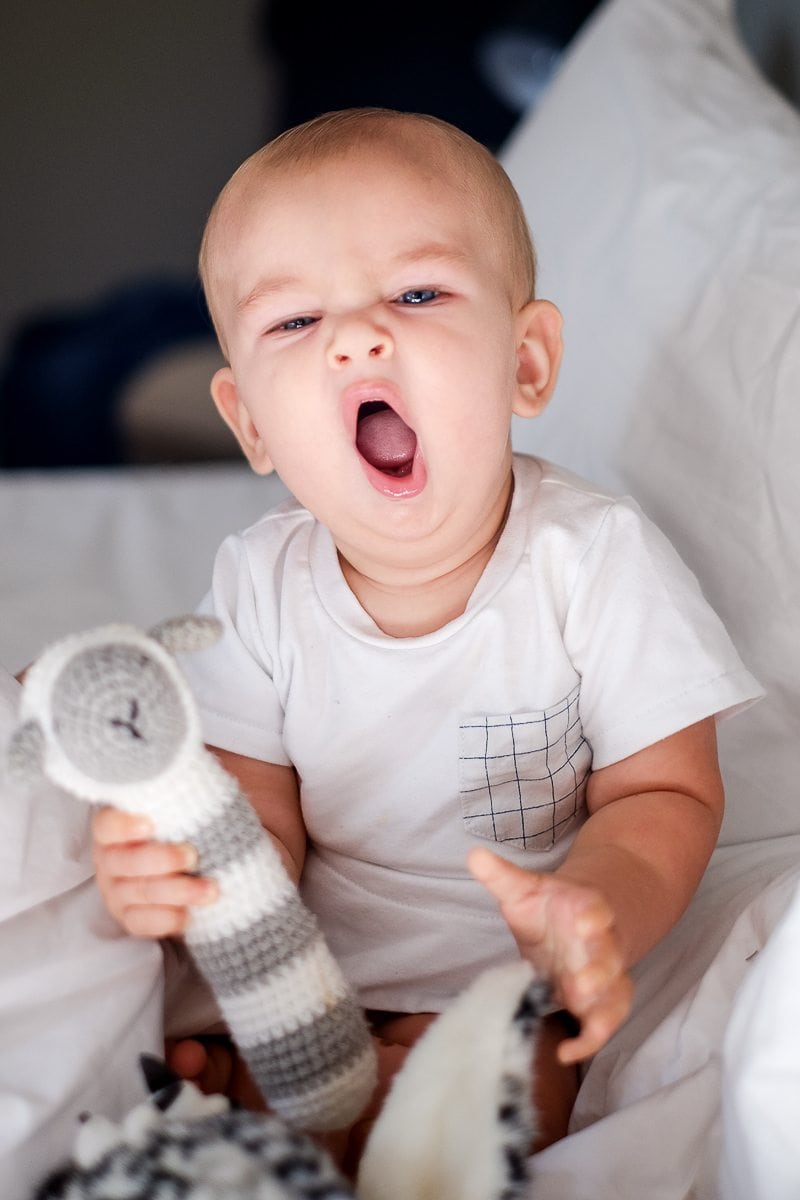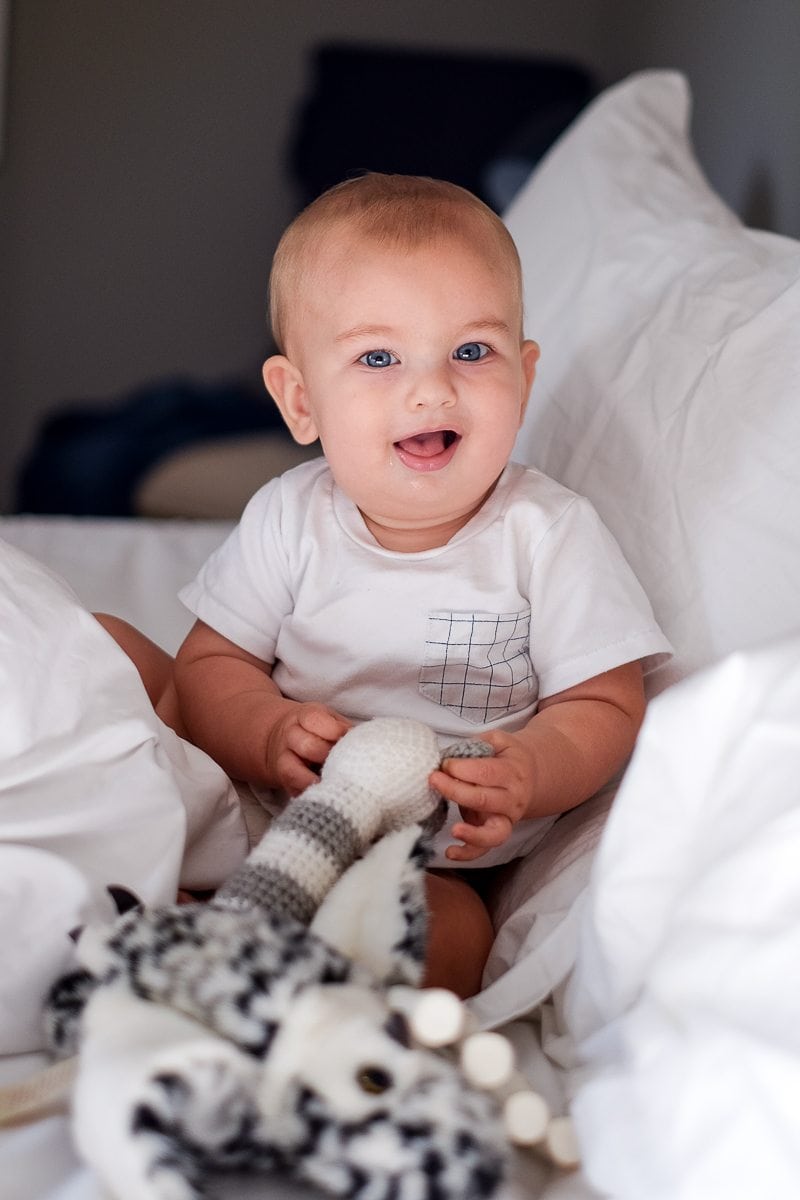
I'm writing this post from France, with a sleeping baby happily napping in his travel crib in the next room. Every time I put Theo to bed and he drifts quickly off to sleep, I am grateful. Grateful to my husband, for his perseverance; grateful to Theo, for being so willing to change; and grateful to all of the sleep advice I received from books and blogs and friends.
It took us a solid month to transition successfully from co-sleeping to Theo happily sleeping independently in his crib. To be very honest, it was a very hard process, with a lot of tears, his and mine. Before we started, Elie and I thought carefully about whether or not 'sleep training' was right for us and whether it was right for Theo. We weighed the pros and cons and decided it was in Theo's best interest, so he would get the sleep he needs and develop good sleep habits throughout his childhood, and perhaps his lifetime. It was one of the first hard decisions to make as a parent--to make our child very unhappy by doing something good for him.
But boy, was it worth it. Prior to the transition, Theo slept eight or nine hours at night and napped for maybe two, sometimes three hours during the day, if we were very lucky. He slept a total of 11 or 12 hours a day, which is not enough for an infant. After the transition, Theo now gets a solid 14 hours a day of good-quality, restful sleep in his crib, about 10 - 11 hours at night and three to four hours of naps during the day.
Here's a little background about what led us to sleep training, and how we did it.
Theo started off being a great sleeper. In those early months, Elie and I very rarely had a sleepless night, unless he had a tummy ache, which wasn't often. He napped well during the day and could easily nap on the go. We took him to parties, out to restaurants, shopping in and out of stores, on long walks around the neighborhood, and Theo would sleep right through any noise. He also started sleeping through the night at five weeks. Theo would happily go to sleep in his little nest, usually falling to sleep around nine p.m., waking once around four or five a.m. to nurse, and then going back to sleep until seven and eight a.m. He was so easy!
And then the four month sleep regression hit, which actually started around 3 1/2 months. From what I've read, almost all babies start to have more interrupted sleep around this age, because they are waking to the world and start to realize there is more to life than sleep, like playing with Mama and Daddy. I think Theo's 'awakening' and difficulty settling to sleep was compounded by the fact that I had often let him sleep on my chest. Since he was born, he would sometimes gag from some sort of reflux, and it would look and sound like he was choking. It was never diagnosed, but it scared me to death, because I was afraid he would choke or aspirate his saliva. And so if I heard him gag in the night, I would scoop him up and put him on my chest, and we would both sleep that way for the rest of the night. I think he got used to it. And so did I.
In the beginning, it was heaven. Who doesn't want their sleeping baby cuddled up so close to them? And when he was so little, I could easily go back to sleep with him on my chest and sleep soundly. But as he got bigger and heavier, and more restless in his sleep, it started to be hard for me to sleep with him on my chest. But by then, he'd gotten used to it. Add that to the four month sleep regression, and it started to be hard to get him to sleep in his nest.
For naps, it was almost impossible to get him to sleep in his nest. I would nurse and rock him to sleep, and he would wake up the moment I put him down. Then he would be awake for another 90 minutes until his next sleep cycle began. So, from about 3 1/2 to five months, he mostly napped on my chest. Sometimes we would put him in the car and he would go to sleep, usually after 20 minutes of crying. Or sometimes we could put him in his car seat and swing him to sleep. For bedtime, it would sometimes take four or five tries before he would stay in his nest, asleep. I giggle when I think of some of the stealthy moves we invented to get him to stay asleep. It was craziness.
At almost five months, he stopped napping on my chest. He was just too big, and he couldn't get comfortable to stay asleep for long. He would sleep for 25 minutes and then wake, looking up at me with a big grin. But, because he wasn't getting good sleep, he would quickly become cranky, but he wasn't sleepy enough for another nap. It was time for some sleep work.
I read a lot of sleep books during those hours and hours Theo napped on my chest. The Happy Sleeper, The No Cry Sleep Solution, The Sleep Lady all provided great information for us to use in our decision-making, as well as the experiences of many friends. While I would have preferred a no-cry sleep solution, those techniques just weren't working on Theo. Believe me, I tried. Ultimately we decided to go with a modified version of the techniques outlined in The Happy Sleeper, which is essentially a softer, supported version of a cry-it-out approach.
Elie and I created a very specific, detailed plan for Theo's transition to the crib. We picked a specific day, a week or so after he turned five months old, when he didn't have any immunizations scheduled and we didn't have any plans to be away from home or have visitors. The plan went like this:
The first night we started sleep training, he cried for 38 minutes. And by cried, I mean screaming, flailing, crying. It was torture. He cried and I cried. After we did the bedtime routine and put him in his crib, Elie encouraged me to leave the house and go for a walk and he would do the checks. He sent me texts to tell me how it was going, and told me when to come home and have a glass of wine. That first night, Theo woke twice during the night, and we had to do five minute checks both times to get him back to sleep. Elie and I both got up in the night, to support each other.
The second night, he cried for 36 minutes before falling asleep. That night, when he woke to nurse, he went right back to sleep without crying. Victory!
The third night, he cried for 33 minutes before falling asleep. Again, when he woke during the night, he went right back to sleep without crying.
The next night, he went to sleep in 12 minutes, and for the four weeks (yes, four long weeks), he would cry somewhere between 30 seconds (those were good nights!) and 20 minutes (those were hard). And then after about a month, he started happily going to sleep after his bedtime routine. We put him in his crib and he would roll over and close his eyes and go to sleep. Boy did that feel good.
As I said earlier, we waited about a week to start the nap training, and then we started applying the same method to naps. Theo takes three naps a day, and he goes down for a nap about 2 hours after he wakes from his previous sleep. For example, if he wakes at 7 a.m., his first nap is around 9 a.m. We let him sleep as long as wants to and can, and sometimes that's 45 minutes and sometimes it's 2 1/2 hours. So, if he wakes at 10:30 a.m., his next nap will be around 12:30 p.m. We feel like this baby-centered schedule is better for Theo, even though it makes it harder for us to plan our days. But with this schedule, we're putting him down when he's tired and we're letting him get as much sleep as he needs, instead of using a parent-centered approach where we dictate the nap times and the length of naps. Sometimes, if he has a long morning and afternoon nap, he will skip the third nap, and we put him to bed early.
Because nighttime sleep was well-established, the nap sleep training was pretty easy, and soon he was happily sleeping for three naps a day. We use an abbreviated version of the nighttime routine before naps: reading a book, nursing and singing, saying goodnight to things in the room, in the crib. If he cries (which he did at first, but he rarely does any more), then we do the same five minute checks we do at night, using the same script. He usually cries for less than five minutes.
It's now been over two months since we started sleep training, and we very rarely have to do five minute checks anymore, for naps or nighttime sleep. If we do, it's usually because we've let him get overtired and he has a hard time relaxing and falling asleep. In these cases, we now tend to do a little bit of soothing, picking him up and singing and bouncing him, until he gets sleepy and relaxed enough to fall asleep.
That's our story of transitioning Theo from co-sleeping to the crib. Was it easy? No. But was it worth it? Absolutely! He's getting better sleep, sleeping longer and more soundly, and he's waking up cheerful and ready to play. And I've found more balance in my days, because I'm not spending two to three hours a day holding him for his naps. Don't get my wrong, I love cuddling my son and he still get plenty of cuddles and love. He's just awake now to enjoy it.

After going through this experience, I have a few additional thoughts about sleep training, which hopefully will help you, if you're trying to make the right sleep decision for yourself and your baby.
Good luck! And you can do it. If I can provide any additional help or support, please send me a message.
I love when I see an email from a friend, and that’s how I think of you. I hope you feel the same. In my newsletter, I share the kinds of recipes and stories I used to blog about. You’ll get the recipes I’m cooking for my family as well as anything else I think might bring more connection or more joy.